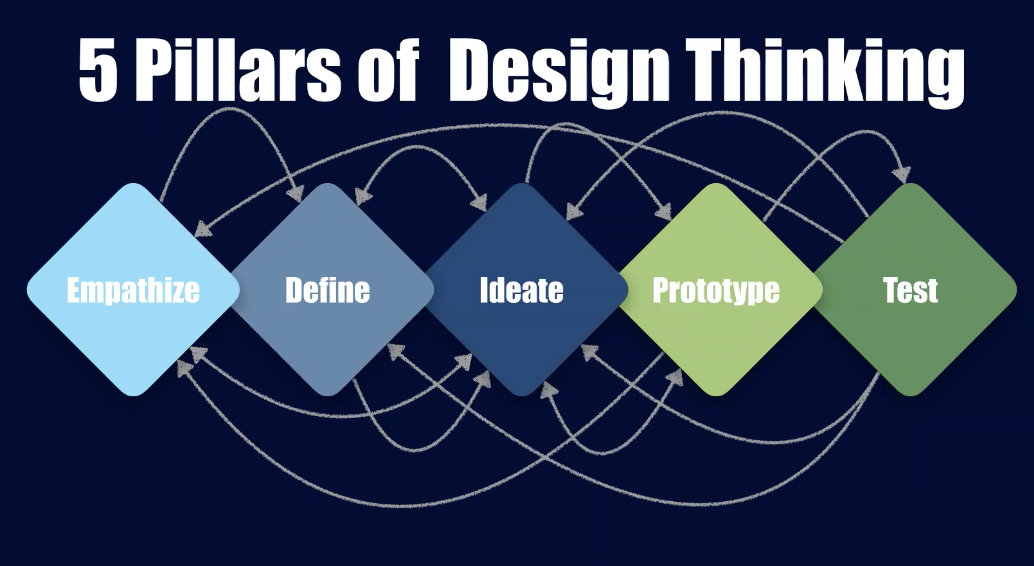An introduction to design thinking

The Grio design team has grown in both size and expertise over the past few years, and as our Design Manager, I spend a fair amount of time thinking about how we can improve our tools and processes to continue supporting that growth. One step I’ve taken has been to formally integrate a design thinking approach into all of our projects. In this post, I’ll provide a brief introduction to design thinking, explain how it works in practice, and dig into the critical role of empathy in good design.
What is design thinking?
Design thinking is a human-centered design methodology that provides a solution-based approach to problem-solving. It’s comprised of 5 major components, or “pillars”:
- Empathize: Understand users and stakeholders
- Define: Frame problems in user-centric ways
- Ideate: Brainstorm multiple solutions
- Prototype: Model solutions to demonstrate their functionality
- Test: Validate solutions with users and stakeholders
The design thinking process isn’t linear; it’s highly flexible, and the pillars can be repeated, skipped, or implemented in different orders, depending on the nature of the problem being solved. Usually, it ends up looking something like this:

Why should you use a design thinking approach?
Design thinking is a proven methodology with solid roots in academia. It’s widely used by top software companies — including Google, Apple, and Salesforce — to develop new products, improve existing products, and streamline development processes.
Additionally, design thinking is now taught not only in top universities (including Stanford, MIT, and the University of Maryland), but also in several elementary and secondary schools across the U.S. The next generation of designers and developers will be grounded in design thinking, and companies that start implementing it now will be the best positioned to take advantage of their skills.
Design thinking also isn’t limited to product or software design. It can be applied to many different types of problems, and has been used to improve a wide variety of business systems and processes. Earlier this year, for example, an article in Forbes called design thinking the “future of sales”.
How design thinking looks in practice
Here at Grio, we offer a full range of design and development services, from user research to deployment and QA. The graphic below shows how the design thinking process maps to those different aspects of our work:

A quick Internet search surfaces dozens of other examples of design thinking in companies of all shapes and sizes. A few of my favorites include:
- Pepsi’s CEO has embraced design thinking and uses it company-wide; all new products, campaigns, and processes now go through a complete design thinking process.
- IDEO and UCSF are working together to apply design thinking to specific problems in healthcare, including developing improved protocols for patients with schizophrenia.
- Airbnb is a poster child for design thinking. Believe it or not, Airbnb was a failing business just a decade ago; in 2009, they were making only about $200 per week. A design thinking approach helped them break out of the code-centric mentality of Silicon Valley to identify the human problems — and simple solutions — that were preventing them from realizing their business’ potential.
The importance of empathy — and interviews — in design
Let’s zero in on the first pillar of design thinking: empathy.
Almost everyone has had a frustrating experience with a software product at one time or another. We usually blame ourselves for “failing” to use a product correctly, or for finding the interface confusing, when the actual problem is uninformed design decisions. A while back, while conducting user testing for some particularly cumbersome ERP software, I had an interviewee tell me that a product would be “intuitive once I learn how to use it” — a perfect example of a user struggling with a clunky interface and putting the onus back on himself to work around the problems.
As designers and developers, it’s critical that we understand a user’s needs and perspective. Users want our products to work. They want to feel capable when they interact with software. However, if you’ve made a career of software design or development, you’ve almost certainly worked on at least one product that confused users. It was likely not deliberate because, of course, you also had constraints — time and budget limitations that might have prevented you from creating a better solution — but if you didn’t build empathy by actually talking directly to users, the product you created fell short of the best you could do.
User interviews, or even more casual interactions with your end-users, will help you uncover new solutions and identify problems that you didn’t previously know existed. They’ll help you answer critical design questions, including:
- Who is the user? What’s their level of technical skill (or other relevant knowledge)?
- When and where will the user use the product — at home, at work, in the car? Will they be near hazards, such as water or heavy machinery, or in a high-stakes situation that requires quick decisions and actions?
- How should the user move around the product? What types of navigation and wayfinding elements would be most appropriate?
- What actions does the user need to control? What can we do for them in the background?
- Are there cultural factors (e.g., languages, different currencies, or cultural sensitivities) that we need to account for in our design?
- How do we want the user to feel? How can we use colors, typography, and imagery to evoke feeling?
Empathy is only one pillar of design thinking, but I believe it may be the most important. Without empathy, our designs lack a human connection — and in any design project, it’s the people that matter most.
